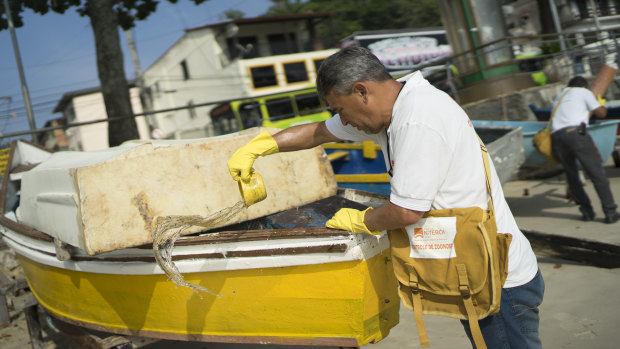
Dengue is a viral infection transmitted to humans through infected Aedes aegypti mosquitoes which also transmit yellow fever and Zika among other diseases. Many people infected never develop symptoms, but others get a high fever, headaches, body aches, nausea and a rash. While most get better after a week or so, some develop a severe form that requires hospitalisation, causes internal bleeding, and can be fatal.
Frequent rains and high temperatures, which accelerate the hatching of mosquito eggs and the development of larvae, make the famously hot city of Rio especially susceptible. Every couple of years, outbreaks become epidemics.
Despite the low number of cases, the city of Niteroi, like its neighbours, is still investing heavily in prevention. Every day, hundreds of city health workers are sent to survey neighbourhoods, streets, rooftops, forested areas, small businesses and rubbish tips to promote best practices, mostly watching out for any standing water where mosquitoes could lay their eggs.
On Friday, under scorching heat, Augusto Cesar, 63, climbed up the Morro da Penha, or Penha Hill, a low-income neighbourhood, known in Brazil as a favela. For more than two decades, the council worker has been entering residents’ homes, climbing roofs, picking up rubbish and inspecting every corner of the neighbourhood, looking for stagnant water. Even the cap of a plastic bottle, if filled with rain water, can become breeding ground for larvae, he said.

A health agent scoops water from a boat docked at the Jurujuba beach during an operation to eradicate the Aedes aegypti mosquito, in Niteroi, Brazil.Credit: AP
“The greatest challenge is access,” Cesar said, pearls of sweat trickling down his face. Favelas, often built informally, can be hard to navigate, like mazes. After spotting a large plastic water tank on a roof that he would like to inspect, Cesar makes his way through a tiny alley, squeezed between two walls of concrete and red bricks, but fails to find a path to the rooftop.
Loading
Further down the road, he spots two more unsealed water tanks. He climbs a wall and starts removing the loose sheets of metal covering them. He installs mosquito nets and replaces the metal sheets. In a shady alley, he lifts the tops of two other water tanks, gets a flashlight and scrutinises the surface for any sign of mosquito larvae.
Another challenge, said Fiocruz researcher Luciano Moreira, is security, with vast swaths of the city run by either drug traffickers or militias. Moreira leads the Wolbachia project in Brazil.
Dozens of municipalities have reached out to national and city authorities, Cesar and Moreira said, anxious to implement the Wolbachia method on their own turf. The Health Ministry announced late last year plans to build a large factory to breed Wolbachia-carrying mosquitoes that, over the next 10 years, will be able to produce 100 million eggs per week, 10 times Fiocruz’ current capacity.
AP